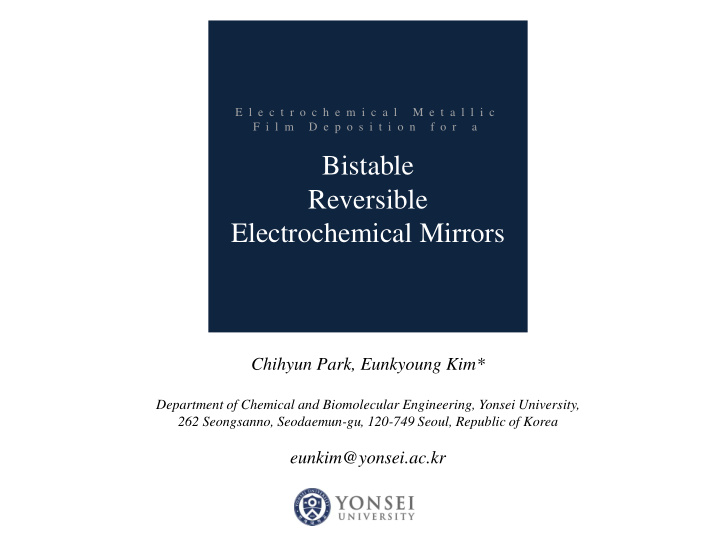



E l e c t r o c h e m i c a l M e t a l l i c F i l m D e p o s i t i o n f o r a Bistable Reversible Electrochemical Mirrors Chihyun Park, Eunkyoung Kim* Department of Chemical and Biomolecular Engineering, Yonsei University, 262 Seongsanno, Seodaemun-gu, 120-749 Seoul, Republic of Korea eunkim@yonsei.ac.kr
Contents 1 Introduction 2 Electrochemical Stability of REM Device 3 Bistable Reversible Electrochemical Mirror 4 Conclusion
Introduction Enhance stability & Contrast of ETS Design of multi-color electrochromic materials Research Objectives Fabrication of flexible & foldable devices Long memory effect for an energy saving and low- ETS power consumption ETS Polymeric ETS Electro- Enhance electrochemical stability of mirrors transmittance Optimize device conditions for faster switching speed Switching Fabrication of multi-mode ETS Enhance bistability for an energy saving and low- power consumption ETS Metallic ETS Reversible electrochemical mirrors (REMs) are designed to modulate their reflectance, from a highly reflective state enough to mirror a subject to a highly transparent state, according to external stimuli such as electricity, light, or heat. Herein, we report an electrochemically stable, and bistable reversible electrochemical mirror (BREM) , for the first time, by using a reversible silver deposition on a thiol modified ITO electrode in ionic liquids as the electrolyte media. “Switchable Silver Mirrors with Long Memory Effect” Chem. Sci., Inpress (2014) 1
Electrochemical Stability of REM Device A thiol modified electrode (TI) was prepared by anchoring the plasma- treated ITO electrode with (3- mercaptopropyl) trimethoxysilane (MPTMS). The Ag-Cu metallic film formed on TI (TITBAB) showed dramatic enhancement in its long-term electrochemical stability. The metallic film was also stable, showing a highly reflective state without rupture. On the other hand, the metallic film grown on the bare electrode (UITBAB) showed instability after a few minutes at -2.5 V. The metallic films were ruptured, and the reflectance dropped significantly. The average roughness of Ag film on UI was 66 nm, which was twice larger than that on TI (33 nm) Scale bars, 1μm 2
Bistable Reversible Electrochemical Mirror We used an ionic liquid (IL) as an electrolyte for the switching mirrors, taking advantage of the large specific capacitance of ILs. In addition, the nonvolatile, nonflammable, and highly viscous natures of IL confer advantages in REM. Surprisingly, the reflectance of the TIBEIB was maintained after electricity was disconnected (V-Off). The reflectance of the TIBEIB, following application of -2.5V for 30 min, had a slight further increase to 89.3% immediately after V-Off state. Electrical double layer (EDL) worked as an ion blocking layer. Pyrene was used to elucidate the ion transport. 3
Conclusion An electrochemically stable and bistable electrochemical mirror was achieved for the first time by introducing 1) a thiol-modified ITO electrode for the stabilization of the Ag-Cu metallic film and 2) ionic liquids as the anion-blocking layer to achieve bistability in the switching mirror. In view of their long memory effect and electrochemical stability, the switchable mirrors could find numerous applications, such as smart windows for energy saving buildings and automobiles, wireless heater, reflective displays, and switchable mirrors for optical systems. 4
Recommend
More recommend